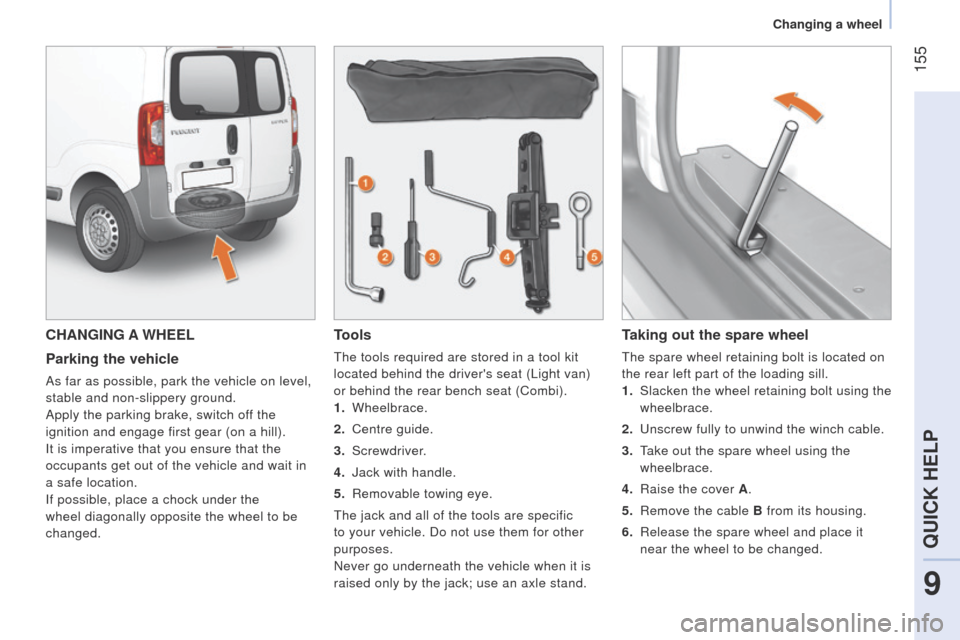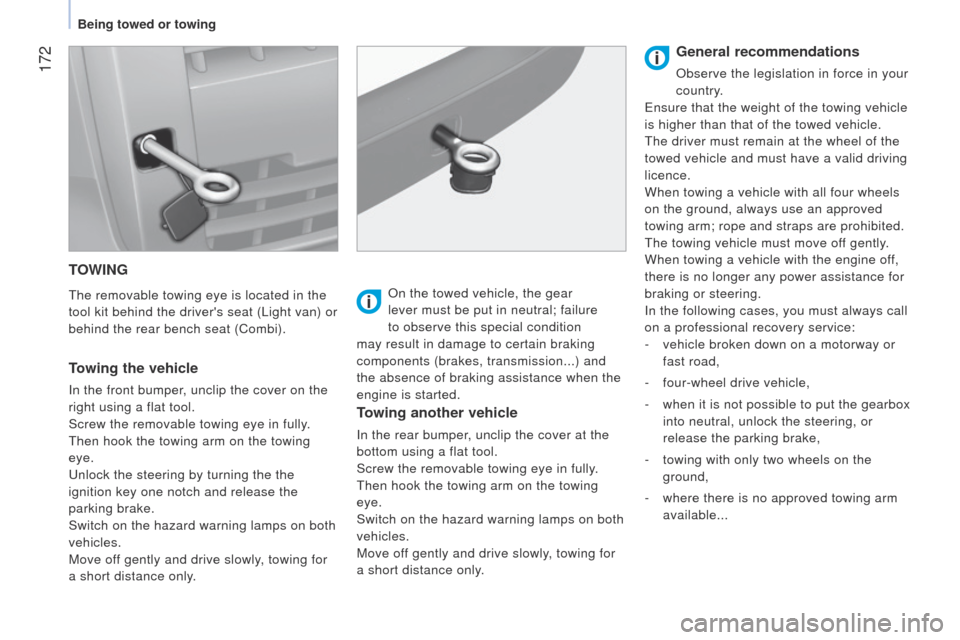Page 157 of 192

155
Bipper_en_Chap09_aide-rapide_ed02-2014
CHANGING A WHEEL
Parking the vehicle
As far as possible, park the vehicle on level,
stable and non-slippery ground.
Apply the parking brake, switch off the
ignition and engage first gear (on a hill).
It is imperative that you ensure that the
occupants get out of the vehicle and wait in
a safe location.
If possible, place a chock under the
wheel diagonally opposite the wheel to be
changed.
Tools
the tools required are stored in a tool kit
located behind the driver's seat ( l ight van)
or behind the rear bench seat (Combi).
1.
Wheelbrace.
2.
Centre guide.
3.
Screwdriver.
4.
Jack with handle.
5.
Removable towing eye.
t
he jack and all of the tools are specific
to your vehicle. Do not use them for other
purposes.
Never go underneath the vehicle when it is
raised only by the jack; use an axle stand.
Taking out the spare wheel
the spare wheel retaining bolt is located on
the rear left part of the loading sill.
1.
Slacken the wheel retaining bolt using the
wheelbrace.
2.
u nscrew fully to unwind the winch cable.
3.
t
ake out the spare wheel using the
wheelbrace.
4.
Raise the cover
A.
5.
Remove the cable
B from its housing.
6.
Release the spare wheel and place it
near the wheel to be changed.
9
QUICK HELP
Changing a wheel
Page 159 of 192
157
Bipper_en_Chap09_aide-rapide_ed02-2014
Fitting a wheel
6. Put the trim back in place, starting by
placing its notch facing the valve, and
press with the palm of your hand.
7.
Stow the tools and the wheel.
8.
Check the tyre pressure and have the
balance checked. Refer to the "
t
echnical data -
Identification markings" section for
the location of the tyres sticker bearing the
recommended tyre pressures.
1.
Put the wheel in place using the centre
guide 2 to assist you.
2.
Screw in the 3 bolts by hand and remove
the centre guide. Position the 4th bolt.
3.
Pre-tighten using the wheelbrace
1 .
4.
Fold the jack
4 and detach it.
5.
t
ighten the wheel bolts using the
wheelbrace. Have the tightening of the bolts and the
pressure of the spare wheel checked
by a P euge O t
dealer or a qualified
workshop without delay.
Also, have the original wheel repaired and
refitted by a P euge O t
dealer or a qualified
workshop as soon as possible.
9
QUICK HELP
Changing a wheel
Page 172 of 192
170
Bipper_en_Chap09_aide-rapide_ed02-2014
Marking RatingFunctions
F01 60 AControl unit.
F02 40 APassenger compartment fan.
F03 20 AStarter motor supply.
F04 40 AABS hydraulic block pump supply.
F06 30 ASingle speed cooling fan control.
F07 40 AHigh speed cooling fan control.
F08 30 AAir conditioning compressor.
F09 15 A
towbar harness.
F10 10 AHorn.
F
11 10 A
e
ngine management secondary load supply.
F14 15 AMain beam headlamps.
F15 15 A12 V accessory socket.Table of fuses in the engine
compartment
Changing a fuse
Page 174 of 192

172
Bipper_en_Chap09_aide-rapide_ed02-2014
TOWING
the removable towing eye is located in the
tool kit behind the driver's seat ( l ight van) or
behind the rear bench seat (Combi).
Towing the vehicle
In the front bumper, unclip the cover on the
right using a flat tool.
Screw the removable towing eye in fully.
t
hen hook the towing arm on the towing
eye.
u
nlock the steering by turning the the
ignition key one notch and release the
parking brake.
Switch on the hazard warning lamps on both
vehicles.
Move off gently and drive slowly, towing for
a short distance only. On the towed vehicle, the gear
lever must be put in neutral; failure
to observe this special condition
may result in damage to certain braking
components (brakes, transmission...) and
the absence of braking assistance when the
engine is started.
Towing another vehicle
In the rear bumper, unclip the cover at the
bottom using a flat tool.
Screw the removable towing eye in fully.
t
hen hook the towing arm on the towing
eye.
Switch on the hazard warning lamps on both
vehicles.
Move off gently and drive slowly, towing for
a short distance only.
General recommendations
Observe the legislation in force in your
country.
e
nsure that the weight of the towing vehicle
is higher than that of the towed vehicle.
t
he driver must remain at the wheel of the
towed vehicle and must have a valid driving
licence.
When towing a vehicle with all four wheels
on the ground, always use an approved
towing arm; rope and straps are prohibited.
t
he towing vehicle must move off gently.
When towing a vehicle with the engine off,
there is no longer any power assistance for
braking or steering.
In the following cases, you must always call
on a professional recovery service:
-
vehicle broken down on a motorway or
fast road,
-
four-wheel drive vehicle,
-
when it is not possible to put the gearbox
into neutral, unlock the steering, or
release the parking brake,
-
towing with only two wheels on the
ground,
-
where there is no approved towing arm
available...
Being towed or towing
Page 184 of 192

182
Bipper_en_Chap10_caracteristique_ed02-2014
WEIGHTS AND TOWED LOADS
the maximum weights and towed loads
for your vehicle are given are given in the
registration document, as well as in sales
brochures.
t
hese values are also present on the
manufacturer's plate or label (see the
"Technical data - Identification markings"
section).
t
he kerb weight is equal to the unladen weight
+ driver (75 kg).t he gross train weight and towed load values
indicated apply up to a maximum altitude of
1 000 metres; the towed load mentioned must
be reduced by 10 % for every additional
1 000 metres. High ambient temperatures may result
in a reduction in the performance of
the vehicle to protect the engine; when the
ambient temperature is higher than 37 °C, limit
the towed weight.
towing with a lightly loaded vehicle can
adversely af
fect roadholding.
Braking distances are increased when towing
a trailer.
When towing, the maximum speed allowed is
reduced (comply with the legislation in force in
your country).
For information on the maximum trailer weight
for your vehicle, contact a P
euge O t
dealer or
a qualified workshop.
t
he weight of the braked trailer can be
increased, within the
gt W limit, on condition
that the
g VW of the towing vehicle is reduced
by the same amount.
t
he recommended nose weight is the vertical
load on the towbar ball (removable with or
without tools).
GVW: gross vehicle weight, the maximum
authorised vehicle weight.
GTW: gross train weight, the maximum
authorised weight of vehicle plus trailer.
In all countries, it is essential to comply with
the local legislation on towed loads.
Weights